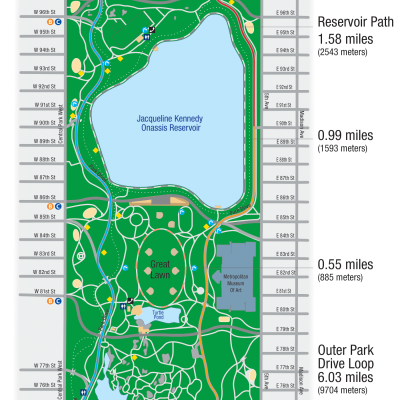Why Central Park is a haven for New York runners
Central Park, situated in the heart of Manhattan, stretches 2.5 miles long and is the most frequented urban park in the nation for good reason. Its beauty and charm especially when the cherry blossoms are in bloom make it not only a scenic destination for tourists attracting 42 million visitors annually, it also has become a mecca for runners of all types. The Central Park running routes extend from Central Park South at 59th Street all the way to North 110th Street giving runners a variety of loops and trails to choose from for all difficulty levels so you never get bored! With so many routes to choose from and with the beautiful landscape of trees, flowers, grass, and historical landmarks it’s no wonder why so many runners and runner’s groups congregate here.
Central Park running map with the best running trails in Manhattan
The Central Park running map is your runners’ guide to finding the perfect running route in Manhattan for your needs. Whether you’re looking for a quick stroll, a place to run hill repeats, a rocky climb, rolling hills, or a longer scenic route there’s a little bit of everything here at Central Park. The loops range in distance from .5 miles to 6+ miles long. The full outer loop of Central Park Drive is about 6.1 miles long and is all cement ranging from flat to hilly terrain.
From there you can branch off to these popular routes:
- The Reservoir Path which runs 1.58 miles long and is on crushed gravel is a great option for beginners.

Image Source: Trip Tins - The Bridle Path loop north of the Central Park Reservoir is 2.5 miles and is also great for all runner levels.

Image Source: Living New Deal
Other less popular routes that are just as scenic include:
- The Great Lawn Oval which contains a paved path that is shaped like a track and measures almost exactly one-half mile.
- The Ramble or the North Woods are great wooded areas to run in to make you forget that you’re even in NYC. These are also great places for bird watching!
- For a hilly climb try the Park’s upper loop or a jog from the Central Park Boathouse to the 79th Street Transverse Road.
Central Park is also a great place to explore and form your own running route. Just make sure you have a map with you because believe it or not it’s easy to get lost if you don’t know where you’re going!
Why strength training will help prepare you for one of Central Park's elite running clubs
While Central Park running clubs like New York Road Runners welcome runners of all levels if you’re looking to become competitive and eventually maybe even qualify for the New York Marathon you’ll need to understand how to train. Performing at your fullest potential as a runner requires more than just racking up miles. To achieve greater speed and efficiency in running, as well as to mitigate the risk of injury setbacks, integrating strength training into your training regimen is essential and we have the science to prove it. Incorporating weight training into your typical exercise routine has been demonstrated to boost both your speed and VO2 max. This is because when you resolve any muscle imbalances you present, improve your neuromuscular coordination and power output, and strengthen your bones and connective tissues your muscles don’t have to exert as much energy to run faster. Better form and technique achieved through strength and mobility training also leads to less wear and tear on your body and muscle breakdown from running. This allows you to build a higher tolerance for the beating your body takes from running on concrete and uneven terrain on NYC running paths. The Central Park running map showcases diverse terrain, ranging from dirt and gravel to rocks, concrete, and grass.
If you are unsure about how to strength train here is a strength training for runners guide to get you started! Incorporating these exercises into your training regimen at least 1-2x per week will be sufficient enough for you to see improvements in how you run within just a few months. The key is consistency and making sure you don’t overdo it. You may need to cut back on some of your running mileage to allow for sufficient recovery for your strength training workouts. Make sure to incorporate a rest and recovery day into your weekly training schedule to prevent overtraining.
We connect with NYC runners at Leading Edge on a personal level

At Leading Edge we understand why running is such an adrenaline sport. Our co-founder, Noelle, holds a deep passion for running. From her early years, she engaged in track and field and cross country throughout high school and college, even setting the collegiate record at a D1 university in the 1000 meters. Furthermore, she has prepared for and completed a half-marathon, as well as numerous 5K and 10K races. Drawing from her personal journey, she possesses firsthand insight into the significant role strength training plays in enhancing running form and pace. One of her biggest regrets in her career as a runner and athlete is not adopting a solid strength training routine sooner. With the knowledge she has now, she is confident that she could have prevented certain injury setbacks and potentially earned more medals.
This is why it’s our mission at Leading Edge to help equip NYC runners with the foundation in their training that they need to become great runners even if they’ve never ran before. We delve deeply into form and technique, evaluating your stance and movement to identify areas of your body prone to injury that require strengthening, mobility and stability enhancement, and alignment correction. Our exercise programming is tailored to address these crucial deficiencies in your form and body mechanics, aiming to transform you into a more versatile runner and provide you with a competitive advantage that you may not have experienced before.
Book your free phone consultation with us today so we can get you prepared for your next competition or fun run using your central park running map!
Tips for running at Central Park
Now that your running performance resembles that of a true athlete, you might find these tips helpful for navigating Central Park and planning your next race in the area.
- Central Park hours every day are from 6 am to 1 am. Although it’s generally safe to run in Central Park at night we recommend sticking to the well-lit paths and more populated areas after dark.
- There are bathrooms and water fountains located throughout the park which you can easily locate on your central park running map. It’s important to note that most of the bathrooms are open year-round however the water fountains shut off during the winter.
- To be on the safe side if you are running alone especially after dark it’s recommended that you carry an ID and emergency contact number with you. For your safety, there are emergency call boxes located all around the park which are well marked in the central park running map.
- The recommended running direction is counterclockwise – but technically you are permitted to go either way.
- Remember that you are often sharing the road with cyclists so be aware of your surroundings especially when crossing the road and be sure to avoid the bike lanes.
- If you’re looking for a race to do in Central Park, the New York Road Runners race calendar lists all their races for the current year and registration info.
Whether you’re a seasoned runner or just starting out, Central Park offers a haven to lace up your shoes and explore. With a variety of scenic routes and stunning landscapes, it’s no wonder Central Park is a favorite destination for runners in New York City. So next time you’re in the city, don’t forget to pack your running shoes and experience the magic of Central Park for yourself.





